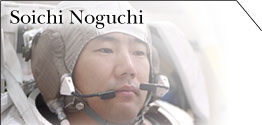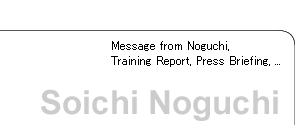Astronaut Soichi Noguchi's Training Report for STS-114 Mission, #15
Resuming Mission-Specific Training and Preparation for Return to Flight (Part3) Joint Integrated Simulation with the MCC
Last Updated: June 13, 2005
Hello to everyone in Japan. We have less than two month until the launch of STS-114. The crew is preparing for the mission and the Shuttle is in its final stages of assembly in preparation for the launch date.
In this report I will talk about the Joint Integrated Simulation (JIS) with the Mission Control Center (MCC).
Just Like The Real Flight
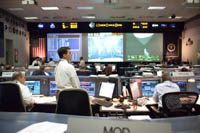 |
| MCC |
It can be said that the JIS is a very big event, which is the culmination of all of the training that has been conducted over the past year. The key players for the STS-114 mission, the Shuttle crew members, the Flight Control Team at MCC, and the Mission Management Team (MMT) are all active participants in the JIS. During the JIS, the flight plan is conducted just as if it were an actual flight. The daily trainings that we have done so far are focused on practicing each and every maneuver, but this integrated exercise is like a full dress rehearsal. The training is complete. The manuals are fully prepared. But are you sure that you have not missed anything when everything was put together? Are there any items that need to be worked on between the MCC and the MMT? This simulation is conducted to make sure that all those types of questions are fully answered. From our point of view, the crew, this was a valuable opportunity to run a thorough check on where each crew member stands during the flight, the timing of all of the communications with the MCC, and an opportunity to correct or revise any unclear parts within the manual.
48 Hour Endurance Training
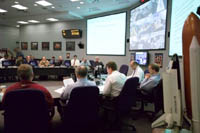 |
| MMT |
Out of sixteen simulations planned before the flight, the JIS was the most complex and the most time consuming. The simulation lasted over forty-eight hours and it covered procedures from take off to the docking with the ISS. The JIS was not just lengthy. The JIS also involved the participation of the MMT, which is the decision making body for the mission's operation. The MMT's participation was of importance in simulating not only the on-site tasks but also the decision making process by management. Anomaly scenarios planned in advance but not made known to the crew and flight controllers are thrown in one after another, and we had to resolve and react to them properly and in a timely manner. This meant that we must carry out the regular operations, as per the planned schedule, and at the same time, be able to respond and resolve any anomalies without delay. In situations similar to this, it is crucial to have smooth communications between the crew and the MCC, appropriate and quick decisions by the MCC, and the crew must be able to execute tasks flawlessly.
And now, it's time for Lift-Off!
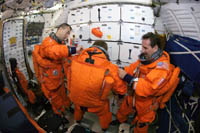 |
| The Astronauts wearing the ACES |
Let's start the JIS. Just as it will be during the actual day of the launch, we wear pumpkin orange colored suits, known as Advanced Crew Escape Suit (ACES). We entered the simulator at the same time that we will on May 15th, the current scheduled launch date. As the Solid Rocket Boosters (SRB) ignited at the time same as they would during the actual flight, the communication with the MCC commences. The first words from the Shuttle to Houston is from the Shuttle Commander, reporting that the Shuttle is operating without any problems.
"Houston, Discovery, Roll Program!"
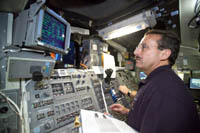 |
| Astronaut Charles Camarda checking on the simulation data |
All operations, such as the launch, orbit insertion, computer set-up, and the robotic manipulator initial set-up, are conducted as per a timeline. We have trained on each of these tasks numerous times, but we paid special attention to such things as, are there are any differences between the manual and the actual work that's done, are there any problems with the seven crew members performing their assigned and multiple tasks in the crowded cockpit, and are the communications between the ground and the crew going smoothly? The anomaly scenario for this JIS was the debris hitting the left wing right after the launch, which resembled the Columbia Accident. The newly installed sensors in the wings confirmed the impact, and the inspection, using the Orbiter Boom Sensor System (OBSS), became the center of attention. The inspection of the Shuttle by Astronaut Andrew Thomas, Astronaut Charles Camarda, and Astronaut James Kelly was conducted. The data obtained by the laser sensors were sent to the MCC. As soon as the data was received on the ground, the waiting engineers started analyzing the data, and the results were forwarded to the MCC and to the MMT. The time required for the analysis and transmission of the information, the contents of the debate at the MMT, and the time needed for decision making will all become valuable data for use during the actual flight.
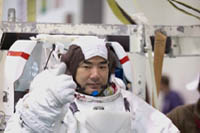 |
As part of the Return to Flight activities, this JIS accumulated a lot of attention from both inside and outside of NASA. I was surprised that this event was even broadcasted live on NASA TV. A friend who had seen the broadcast told me, "It was just like watching the actual flight mission." So in a sense, NASA TV was doing a rehearsal as well. Anyway, we are over a big hill otherwise known as the 48 hour integrated JIS. The crew is preparing to run, without stopping, up the last tough hill during the upcoming eight weeks.
March, 2005 From Houston
